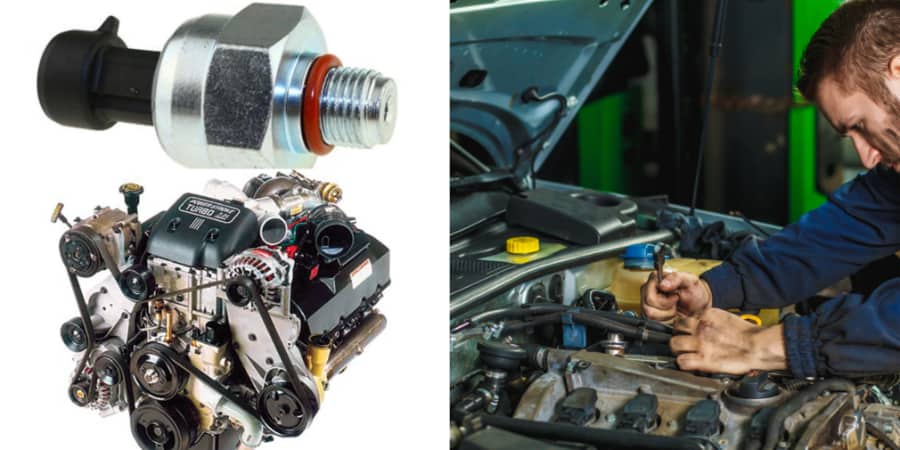
If you own a truck, you know that many different error codes can pop up, and it can be extremely difficult to understand what they all mean and how to fix them. One of these possible codes is the P1280 code.
The P1280 code on a 7.3 Powerstroke engine means the Injection Control Pressure (ICP) sensor is out of range, usually due to a faulty sensor. The best way to fix this problem is to replace the sensor with an Original Equipment Manufacturer (OEM) part.
If you have a P1280 code, you should address the issue immediately. In this article, I’ll discuss what the P1280 code could mean and how to fix it.
How To Fix a P1280 Code on 7.3 Powerstroke Engine
A 7.3 Powerstroke engine uses a high-pressure oil system, so it needs a sensor to keep it in check and operating as it should.
The Injection Control Pressure (ICP) sensor tracks the oil pressure to help send fuel to the engine successfully. The diesel engine relies on this rating to create power and move the vehicle forward.
When a warning code appears, something is not operating properly. The P1280 code almost always means the ICP sensor is faulty, so you’ll need to replace it.
However, before replacing the ICP sensor, you should first make sure that a defective sensor is the problem. Disconnect the sensor and see if there’s oil on the wiring connector.
If there is oil, the ICP sensor is bad, and you should replace it by following the steps below.
13 Steps To Replacing the ICP Sensor
- Disconnect the car battery.
- Remove the serpentine belt.
- Remove the alternator.
- Locate the ICP sensor. The ICP sensor is on the front of the engine on the driver’s side. It should be near the High-Pressure Oil Pump (HPOP).
- Disconnect the negative battery cables.
- Find the retaining clip. Pull it away from the sensor. Pulling this clip away will remove the connector from the ICP.
- Pull the old ICP sensor until it comes away from the cylinder head.
- Coat the o-ring on your new ICP sensor with fresh oil. The new sensor should be an OEM part.
- Place the new ICP sensor exactly where the old one was.
- Torque the new ICP sensor until it’s at 9 lb/ft.
- Reinstall the connector using the retaining clip.
- Replace the alternator.
- Replace the serpentine belt.
The best replacement sensor is the Engine Dancer ICP Diesel Injector Control Pressure Sensor from Amazon.com. This OEM replacement part delivers accurate information to the control module to help your engine run smoother. It’s made from high-quality material to ensure long service life.
Furthermore, covering the new ICP sensor with engine oil is a great way to ensure the installation goes smoothly. I like the Valvoline Advanced Full Synthetic SAE 5W-30 Motor Oil from Amazon because it offers more protection and maintains its quality longer than most motor oils on the market.
Removing the Serpentine Belt
Replacing an ICP sensor requires removing the serpentine belt. It’s a relatively straightforward process, but you might be nervous if you’ve never done it.
To be confident that you are removing the serpentine belt correctly, follow these steps:
- Disconnect the battery by using a wrench to loosen the nuts on the side of the battery.
- Remove any engine covers.
- Before you loosen the belt, inspect it for damage. You may find that you need to replace your serpentine belt, as most need to be replaced every 40,000 to 70,000 miles. If you need to replace this part, it would be convenient to replace it while you replace your ICP sensor.
- Take a picture of the belt installation to replicate it later.
- Relieve the auto tensioner using a wrench.
- Remove the belt from the pulleys.
When you’re done replacing the ICP sensor, and it’s time to replace the serpentine belt, reference the picture you took of the original application to ensure you put it back the same way.
Many of these steps require the use of a wrench. I like this WORKPRO 2-Piece Adjustable Wrench Set from Amazon.com because it comes with a 6-inch and a 10-inch wrench, and the wrench heads are made with solid materials designed to last and resist corrosion.
Other Symptoms of ICP Sensor Problems

If you’re reading this article, you probably have a P1280 code on your 7.3 Powerstroke. This code clearly indicates an ICP sensor issue. However, there are other symptoms of ICP sensor problems.
1. Your Car Cranks, but it Doesn’t Start
Your ICP sensor helps send pressurized fuel to the engine. Without this, your engine cannot start. So if you try to start your car and hear the chirping sound of the engine, but the car doesn’t start running, this can be a sign of a bad ICP sensor.
Cranking without starting can also indicate other problems, such as insufficient compression, clogged fuel injectors, a bad fuel pump, or bad spark plugs, so be sure to check the status of your ICP sensor before assuming it’s the cause.
2. Your Engine Is Rough Idling
Your car requires a consistent amount of pressurized fuel to idle quietly and smoothly. If the ICP sensor is defective, it might allow too much or too little oil into the engine.
So, if you notice bouncing, shaking, and loud noises when the vehicle is idle, your ICP sensor may be at fault.
Other possible causes include dirty fuel injectors, bad spark plugs, a vacuum leak, or carburetor problems.
3. The Engine Cuts in and out
Stalling is highly stressful and potentially dangerous, so if your engine is cutting in and out, you probably want to diagnose and solve the issue immediately.
An engine might start cutting in and out for many reasons, but a bad ICP sensor is possible. When the ICP is faulty, it can lead to irregular engine pressure, causing the car to stall.
Other potential causes include an empty gas tank, a faulty fuel pump, a dead battery, a dirty air filter, a faulty EGR valve, or a bad fuel mixture.
4. You’re Getting Bad Fuel Economy
If the ICP sensor is defective, the 7.3 Powerstroke engine starts using a pre-programmed fuel schedule instead of taking the suggestions from the sensor. You won’t get the most efficient fuel use, and you’ll probably consume more than you need, increasing your fuel expenses.
However, poor fuel economy doesn’t necessarily mean something is wrong with your ICP sensor. There are many other reasons your vehicle uses more fuel than it used to, including clogged air filters, faulty spark plugs, defective fuel injectors, and more.
Increased fuel consumption can be very frustrating, especially with the high fuel cost. For more information about the expenses associated with having a car, I recommend reading my article on why cars are a waste of money.
5. The Check Engine Light Is on
There are many reasons why the check engine light could be on, including a potential ICP sensor issue.
The truck has an internal computer that detects problems with the engine and its sensors. Although this light is sensitive, you should take it seriously. It could be anything from a loose gas cap to faulty oxygen or ICP sensors.
Does Your Vehicle Have a 7.3 Powerstroke Engine?

If you’re addressing an error code, you should know what type of engine you have. You need to know this information to fix the potential engine issue and purchase the correct replacement parts.
A 7.3 Powerstroke engine commonly sees the P1280 warning code. The 7.3 Powerstroke engine is a diesel engine that offers more reliability than the diesel engines that came before it.
If you’re unsure if you have a 7.3 Powerstroke, check your Vehicle Identification Number (VIN). The VIN is usually on the corner of the windshield. A simple Google search using this number should tell you what type of engine you have.
Here’s a list of vehicles with 7.3 Powerstroke engines:
- 1994 Ford F-Series
- Ford Super Duty 250
- Ford Super Duty 350
- Ford Super Duty 450
- Ford Excursion Sport Utility Vehicles
- Ford E-Series Vans
The 6.0 Powerstroke replaced the 7.3 Powerstroke in 2003. The 6.0 Powerstroke is similar to the 7.3, but the injection system is more technologically advanced and allows for higher injection pressures.
If you have a 6.0 Powerstroke, error codes may differ, but ICP sensor failure symptoms are incredibly similar. Check out my article on ICP sensor failure in a 6.0 Powerstroke for more information.
Other Common Problems with the 7.3 Powerstroke Engine
While a defective ICP sensor is a common problem for 7.3 Powerstroke engines, it’s not the only issue this engine model faces.
Here are other common problems with the 7.3 Powerstroke engine:
- Camshaft Position Sensor failure
- Shorting out heating
- Faulty turbocharger up-pipes
- Exhaust back-pressure valve failure
- Under valve cover harness poor connection
- Cracking filter housing
If you’re having other error codes on your 7.3 Powerstroke engine, check out one of these guides:
Final Thoughts
Unfortunately, when you operate a vehicle that uses an engine, you’ll likely experience various problems and error codes. The code P1280 indicates that the ICP sensor is out of range and you need to replace it.
Replacing the part involves pulling the retaining clip away from the old sensor, removing the old part, and putting a new, well-oiled OEM part in its place.
